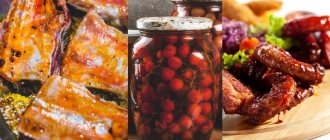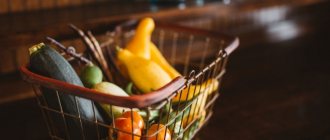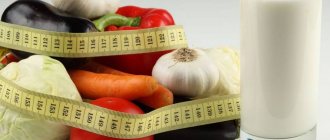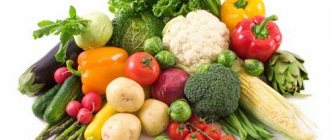General rules
A therapeutic diet is prescribed for diseases and serves specific purposes. For chronic intestinal diseases (without exacerbation or fading exacerbation) with a predominance of constipation Table No. 3 , Diet No. 3 according to Pevzner, which allows you to normalize impaired intestinal functions,
is indicated This is a physiologically complete diet with a predominance of dietary fiber and magnesium, the sources of which are vegetables, fresh fruits, dried fruits, cereals, and fermented milk drinks. The diet includes cold first courses, sweet dishes and carbonated drinks. At the same time, products that increase fermentation and rotting (fried foods), irritate the mucous membrane and stimulate the secretion of the stomach and pancreas (hot spices, horseradish, mustard, etc.) are excluded. Moderate mechanical stimulation and chemical sparing are provided.
Food is prepared mainly in uncut form, boiled in water or baked. Vegetables are recommended raw and boiled. Eating 4-6 times a day. It is important to maintain a drinking regime - 1.5 liters of free fluid per day. This is explained by the fact that the walls of the rectum, with a lack of fluid, begin to absorb water from the stool, they become hard and difficult to pass through the anal canal.
Diet No. 3 for constipation takes into account the effect of foods on the function of the colon, so the maximum includes foods that enhance its peristalsis and eliminate constipation .
Such products include:
- rich in sugars - jam, sugar, syrups, honey;
- containing salt - salted fish, salted vegetables, canned snack foods;
- with a high content of organic acids - pickled and pickled vegetables, sour fruits and juices from them, fermented milk drinks, fruit drinks;
- rich in dietary fiber - bran, legumes, dried fruits, nuts, wholemeal bread, millet, barley, buckwheat, pearl barley, oatmeal, raw vegetables;
- meat with a high content of connective tissue;
- drinks containing carbon dioxide;
- fats in free form, consumed on an empty stomach in large quantities (1-2 tbsp.) sour cream and cream (100 g or more), egg yolks;
- cold dishes (150 C), consumed on an empty stomach or as first courses for lunch - okroshka, beetroot soup, jellied meat, cold jellied dishes, as well as all drinks and ice cream. It is the difference in body temperature and the product taken that is the main factor in stimulating intestinal motility;
- kumiss and kvass, which have a double effect due to the content of organic acids and carbon dioxide;
- prone to swelling - fiber, bran, seaweed;
- sauerkraut is a source of organic acids and fiber.
These are the general principles of nutrition for constipation. If you take a more careful approach to choosing a diet, you should take into account the cause and concomitant diseases of the digestive system:
- If constipation occurs in healthy people due to a sedentary lifestyle, long-term gentle nutrition, but there are no diseases of the digestive system, the general Table No. 15 , but with an increased content of laxative products.
- If constipation occurs against the background of exacerbation of chronic intestinal diseases, the gentle Table No. 4B , and then No. 4B . They exclude coarse fiber and include non-coarse peristalsis stimulants (cold sweet drinks on an empty stomach, vegetable juices, pureed beets, plums, carrots, cauliflower with the addition of vegetable oil, baked apples, kefir).
- Diet No. 5 is indicated , but with an increase in dietary fiber and magnesium (buckwheat, pearl barley, oatmeal, bran and grain bread, millet, vegetable and fruit juices, natural vegetables, fruits, honey).
- In case of peptic ulcer disease and the presence of constipation, the main therapeutic food will be Table No. 1 , but also with an increase in vegetables only in the form of puree, finely chopped and always boiled (carrots, beets, zucchini), well-cooked dried fruits, vegetable oil.
Diet number 3 for constipation in children is not much different from that in adults, but has its own characteristics, which will be discussed in a special section below.
Indications for adults, children
Indications for prescribing diet No. 3 according to Pevzner are diseases accompanied by atonic constipation. Impaired defecation can be associated both with changes in intestinal microflora and with inflammatory diseases in various parts of the digestive tract.
This diet is prescribed during the recovery period. In the acute phase of inflammatory processes, a more gentle diet is indicated, with the exception of fresh vegetables, fruits and coarse fiber foods.
Table No. 3 can be used in the following conditions:
- dolichosigma;
- functional constipation;
- chronic colitis;
- irritable bowel syndrome;
- diverticular disease of the colon.
Authorized Products
Dietary Table No. 3 includes almost all vegetables: beets, carrots, lettuce, cucumbers, tomatoes, pumpkin, zucchini, cauliflower, which can be used raw, stewed and boiled for side dishes, as well as in the form of casseroles. If tolerated well, dishes made from white cabbage and green peas are allowed, but boiled. You can eat vinaigrettes with vegetable oil, vegetable caviar, and seaweed. Due to its swelling properties, it is useful for constipation. It can be consumed dried in powder form or finely chopped 1-3 tsp. per day, soaked in water. Salads and canned seaweed are also recommended.
The first courses are prepared in a weak and low-fat meat/fish broth. Based on the fact that you need to get more fiber, you should prepare mainly vegetable first courses (kholodniki, borscht, cabbage soup, beetroot soup), as well as soups with the addition of pearl barley. Choose lean meats, chicken, turkey - they are easier to digest and “leave” the intestines than heavy fatty meat. Meat dishes are prepared boiled or baked. The same goes for fish.
It should be noted that any meat is a difficult-to-digest product and its daily consumption is undesirable, as many note increased constipation . In this case, you should give preference to fish among protein products, and devote 1-2 days a week to meat. From buckwheat, pearl barley, millet, barley, and wheat cereals, crumbly porridges, casseroles and porridges with the addition of milk are prepared. Equally important is the correct method of cooking food. Fish and meat should be cooked in pieces, and porridges should be crumbly ("smear porridges", including mashed potatoes, are excluded).
Fermented milk drinks contain large quantities of organic acids , so the following are useful for constipation : Varenets, kefir, yogurt, matsoni, kumiss, acidophilus yogurt and they should be present in the diet daily. Milk is only allowed in dishes. Fresh cottage cheese and dishes made from it are welcome: puddings, casseroles with added cereals, lazy dumplings.
Cream, mild cheese in small quantities and sour cream are allowed in dishes. You can eat up to 2 eggs a day and cook them in the form of steam omelettes, omelettes with vegetables, and soft-boiled.
The diet should contain unlimited quantities of fresh sweet fruits and berries, soaked dried fruits in their natural form and in dishes, fruits containing plant fiber and sugar (dried apricots, prunes, apricots, figs). The following sweets are allowed: jam, honey, marshmallow, marmalade, milk caramel. Wheat bread is allowed, but made from second grade flour, grain bread, doctor's bread, and if tolerated well, rye bread is allowed. All bread products must be yesterday's baked goods.
You can use unsweetened cookies (biscuits) and dry biscuits. Carbonated fruit and berry drinks and sparkling mineral waters, weak tea, coffee substitutes, bran decoction, rose hip decoction, plum, apricot, carrot, beetroot, tomato and other juices are allowed.
Table of permitted products
| Proteins, g | Fats, g | Carbohydrates, g | Calories, kcal | |
Vegetables and greens | ||||
| zucchini | 0,6 | 0,3 | 4,6 | 24 |
| cabbage | 1,8 | 0,1 | 4,7 | 27 |
| sauerkraut | 1,8 | 0,1 | 4,4 | 19 |
| cauliflower | 2,5 | 0,3 | 5,4 | 30 |
| carrot | 1,3 | 0,1 | 6,9 | 32 |
| pickles | 0,8 | 0,1 | 1,7 | 11 |
| beet | 1,5 | 0,1 | 8,8 | 40 |
| tomatoes | 0,6 | 0,2 | 4,2 | 20 |
| pumpkin | 1,3 | 0,3 | 7,7 | 28 |
Fruits | ||||
| apricots | 0,9 | 0,1 | 10,8 | 41 |
| watermelon | 0,6 | 0,1 | 5,8 | 25 |
| bananas | 1,5 | 0,2 | 21,8 | 95 |
| melon | 0,6 | 0,3 | 7,4 | 33 |
| nectarine | 0,9 | 0,2 | 11,8 | 48 |
| peaches | 0,9 | 0,1 | 11,3 | 46 |
| plums | 0,8 | 0,3 | 9,6 | 42 |
| apples | 0,4 | 0,4 | 9,8 | 47 |
Nuts and dried fruits | ||||
| dried figs | 3,1 | 0,8 | 57,9 | 257 |
| dried apricots | 5,2 | 0,3 | 51,0 | 215 |
| dried apricots | 5,0 | 0,4 | 50,6 | 213 |
| prunes | 2,3 | 0,7 | 57,5 | 231 |
Cereals and porridges | ||||
| buckwheat (kernel) | 12,6 | 3,3 | 62,1 | 313 |
| oat groats | 12,3 | 6,1 | 59,5 | 342 |
| corn grits | 8,3 | 1,2 | 75,0 | 337 |
| pearl barley | 9,3 | 1,1 | 73,7 | 320 |
| wheat bran | 15,1 | 3,8 | 53,6 | 296 |
| millet cereal | 11,5 | 3,3 | 69,3 | 348 |
| barley grits | 10,4 | 1,3 | 66,3 | 324 |
Bakery products | ||||
| oatmeal bread | 10,1 | 5,4 | 49,0 | 289 |
| Rye bread | 6,6 | 1,2 | 34,2 | 165 |
| bran bread | 7,5 | 1,3 | 45,2 | 227 |
| doctor's bread | 8,2 | 2,6 | 46,3 | 242 |
| whole grain bread | 10,1 | 2,3 | 57,1 | 295 |
Confectionery | ||||
| jam | 0,3 | 0,2 | 63,0 | 263 |
| jelly | 2,7 | 0,0 | 17,9 | 79 |
| marshmallows | 0,8 | 0,0 | 78,5 | 304 |
| milk candies | 2,7 | 4,3 | 82,3 | 364 |
| fondant candies | 2,2 | 4,6 | 83,6 | 369 |
| fruit and berry marmalade | 0,4 | 0,0 | 76,6 | 293 |
| paste | 0,5 | 0,0 | 80,8 | 310 |
| Maria cookies | 8,7 | 8,8 | 70,9 | 400 |
| oatmeal cookies | 6,5 | 14,4 | 71,8 | 437 |
Raw materials and seasonings | ||||
| honey | 0,8 | 0,0 | 81,5 | 329 |
| sugar | 0,0 | 0,0 | 99,7 | 398 |
Dairy | ||||
| milk | 3,2 | 3,6 | 4,8 | 64 |
| kefir | 3,4 | 2,0 | 4,7 | 51 |
| cream | 2,8 | 20,0 | 3,7 | 205 |
| sour cream | 2,8 | 20,0 | 3,2 | 206 |
| curdled milk | 2,9 | 2,5 | 4,1 | 53 |
| kumiss | 3,0 | 0,1 | 6,3 | 41 |
| acidophilus | 2,8 | 3,2 | 3,8 | 57 |
| yogurt | 4,3 | 2,0 | 6,2 | 60 |
Cheeses and cottage cheese | ||||
| cottage cheese | 17,2 | 5,0 | 1,8 | 121 |
Meat products | ||||
| beef | 18,9 | 19,4 | 0,0 | 187 |
| beef liver | 17,4 | 3,1 | 0,0 | 98 |
| beef tongue | 13,6 | 12,1 | 0,0 | 163 |
| veal | 19,7 | 1,2 | 0,0 | 90 |
| rabbit | 21,0 | 8,0 | 0,0 | 156 |
Bird | ||||
| chicken | 16,0 | 14,0 | 0,0 | 190 |
| turkey | 19,2 | 0,7 | 0,0 | 84 |
Eggs | ||||
| chicken eggs | 12,7 | 10,9 | 0,7 | 157 |
Fish and seafood | ||||
| herring | 16,3 | 10,7 | — | 161 |
Oils and fats | ||||
| butter | 0,5 | 82,5 | 0,8 | 748 |
| corn oil | 0,0 | 99,9 | 0,0 | 899 |
| olive oil | 0,0 | 99,8 | 0,0 | 898 |
| sunflower oil | 0,0 | 99,9 | 0,0 | 899 |
Non-alcoholic drinks | ||||
| mineral water | 0,0 | 0,0 | 0,0 | — |
| instant chicory | 0,1 | 0,0 | 2,8 | 11 |
| black tea with milk and sugar | 0,7 | 0,8 | 8,2 | 43 |
Juices and compotes | ||||
| apricot juice | 0,9 | 0,1 | 9,0 | 38 |
| carrot juice | 1,1 | 0,1 | 6,4 | 28 |
| plum juice | 0,8 | 0,0 | 9,6 | 39 |
| tomato juice | 1,1 | 0,2 | 3,8 | 21 |
| pumpkin juice | 0,0 | 0,0 | 9,0 | 38 |
| rose hip juice | 0,1 | 0,0 | 17,6 | 70 |
| * data is per 100 g of product | ||||
Table of what you can and cannot eat
List of allowed foods and dishes:
| Name | Characteristic |
| Soups | The basis is weak low-fat meat or fish broth, vegetable broth. Preference is given to first courses of vegetables (borscht, beetroot soup, cabbage soup), you can add pearl barley. Cold fruit soups are allowed. |
| Bakery products, flour | Wheat bread made from second-grade flour, doctor's bread, if tolerated - Borodino bread. You can eat yesterday's baked goods. Unsweetened cookies and dry biscuits are allowed. In small quantities - unpalatable pechevo with fruit. |
| Meat, poultry | Lean meat, chicken, turkey (boiled or oven-baked). It is better to bake as a whole piece, or chopped meat can be used. Milk sausages are allowed. |
| Fish, seafood | All types of lean fish. The fillet is boiled or baked as a whole piece. All types of seafood are allowed. |
| Fermented milk products | Milk can be included in dishes. Any fermented milk products (kefir, yogurt, fermented baked milk, etc.), not too sour cottage cheese and dishes made from it (casseroles, dumplings, cookies on cereal) are welcome. Cream, mild cheese, sour cream can be added to dishes. |
| Eggs | Two eggs a day (white omelet, soft-boiled). Can be used in cooking. |
| Cereals | For preparing porridge. Casseroles from buckwheat, barley, millet. Porridge is cooked in water, milk is allowed. |
| Vegetables | Carrots, greens, beets, tomatoes, cauliflower, pumpkin, zucchini, cucumbers. Raw or boiled as a second dish, for making casseroles. Peas and regular cabbage - boiled if tolerated normally. |
| Snacks | Vinaigrette dressed with oil, fresh vegetable and fruit salads. Squash caviar, mild cheese, low-fat ham, soaked herring, jellied meat and fish dishes. |
| Sweets, fruits | Berries, fresh fruits, as part of dishes. Dried fruits in steamed form and as part of dishes (raisins, dried apricots, etc.). From sweets: marshmallows, jams, honey, jelly, marmalade. |
| Dressings, seasonings | Sour cream or fruit sauce, tomato or cream sauce in a weak fish or meat broth. Seasonings: dill, parsley, bay leaf. |
| Beverages | Tea, freeze-dried coffee. A decoction of rose hips, wheat bran, fruit and vegetable juices (apricots, plums, carrots, tomatoes, etc.). |
| Fats | Drain oil. Dishes can be seasoned with oils. |
Photo: permitted products
List of prohibited foods and dishes:
| Bakery products | Bread made from first grade flour, baked goods, puff pastries. |
| Meat, poultry | Fatty types of meat and poultry, goose, duck. Smoked, preserved. |
| Fish | Fatty, smoked fish, preserved. |
| Eggs | You can't have hard-boiled, scrambled eggs. |
| Cereals | Excluded or limited: semolina, rice, vermicelli, beans. |
| Vegetables | Potatoes – in limited quantities. Completely excluded: onions, garlic, varieties of radishes, and mushrooms. |
| Snacks | Smoked products, spicy and fatty dishes. |
| Sweets, fruits | Dogwood fruits, blueberries, jelly. Chocolates, cream desserts. |
| Sauces, seasonings | Horseradish, mustard powder, pepper. Spicy and rich sauce. |
| Beverages | Strongly brewed tea, coffee beans, cocoa. |
| Fats | Animal and cooking fat. |
Fully or partially limited products
Dishes containing tannins are excluded - these are jelly from quince, pears, bird cherry, blueberry, dogwood, strong tea, cocoa and coffee. Dishes that have a viscous consistency and move slowly through the intestines are slimy soups, mashed potatoes, mashed porridges and jelly. Chocolate and any products with cream are also not allowed. It is worth excluding bread made from premium flour, as well as baked goods made from yeast dough and puff pastry. Unsavory baked goods should be consumed sparingly.
Difficult to digest and remain in the stomach for a long time are: fatty types of meat (duck, goose) and fish, canned food, smoked meats, hard-boiled and fried eggs. They must be excluded from the diet. Spicy dishes, sauces, horseradish and mustard greatly irritate the mucous membranes and disrupt the function of the entire gastrointestinal tract. You should limit foods that cause constipation - rice, semolina, noodles, sago, vermicelli, potatoes, as well as legumes, which may be poorly tolerated.
Table of prohibited products
| Proteins, g | Fats, g | Carbohydrates, g | Calories, kcal | |
Vegetables and greens | ||||
| potato | 2,0 | 0,4 | 18,1 | 80 |
| radish | 1,2 | 0,1 | 3,4 | 19 |
| white radish | 1,4 | 0,0 | 4,1 | 21 |
| turnip | 1,5 | 0,1 | 6,2 | 30 |
| horseradish | 3,2 | 0,4 | 10,5 | 56 |
| garlic | 6,5 | 0,5 | 29,9 | 143 |
Fruits | ||||
| quince | 0,6 | 0,5 | 9,8 | 40 |
| dogwood | 1,0 | 0,0 | 10,5 | 44 |
Berries | ||||
| blueberry | 1,1 | 0,4 | 7,6 | 44 |
Mushrooms | ||||
| mushrooms | 3,5 | 2,0 | 2,5 | 30 |
Cereals and porridges | ||||
| semolina | 10,3 | 1,0 | 73,3 | 328 |
| rice | 6,7 | 0,7 | 78,9 | 344 |
| sago | 1,0 | 0,7 | 85,0 | 350 |
Flour and pasta | ||||
| pasta | 10,4 | 1,1 | 69,7 | 337 |
| noodles | 12,0 | 3,7 | 60,1 | 322 |
Bakery products | ||||
| wheat bread | 8,1 | 1,0 | 48,8 | 242 |
Confectionery | ||||
| pastry cream | 0,2 | 26,0 | 16,5 | 300 |
Chocolate | ||||
| chocolate | 5,4 | 35,3 | 56,5 | 544 |
Raw materials and seasonings | ||||
| mustard | 5,7 | 6,4 | 22,0 | 162 |
| mayonnaise | 2,4 | 67,0 | 3,9 | 627 |
Meat products | ||||
| pork | 16,0 | 21,6 | 0,0 | 259 |
| salo | 2,4 | 89,0 | 0,0 | 797 |
Sausages | ||||
| dry-cured sausage | 24,1 | 38,3 | 1,0 | 455 |
Bird | ||||
| smoked chicken | 27,5 | 8,2 | 0,0 | 184 |
| duck | 16,5 | 61,2 | 0,0 | 346 |
| smoked duck | 19,0 | 28,4 | 0,0 | 337 |
| goose | 16,1 | 33,3 | 0,0 | 364 |
Fish and seafood | ||||
| smoked fish | 26,8 | 9,9 | 0,0 | 196 |
| canned fish | 17,5 | 2,0 | 0,0 | 88 |
Oils and fats | ||||
| animal fat | 0,0 | 99,7 | 0,0 | 897 |
| cooking fat | 0,0 | 99,7 | 0,0 | 897 |
Non-alcoholic drinks | ||||
| instant coffee dry | 15,0 | 3,5 | 0,0 | 94 |
| black tea | 20,0 | 5,1 | 6,9 | 152 |
Juices and compotes | ||||
| jelly | 0,2 | 0,0 | 16,7 | 68 |
| * data is per 100 g of product | ||||
Diet “Table No. 3”: weekly menu for children, list of laxative products for constipation
Dietary nutrition solves not only the problems of body shape and weight correction. For some diseases, adjustments are also made to the patient's diet. For constipation, dietary table No. 3 is indicated. In this article we will talk about its principles, which products have a laxative effect, present an example of a children's menu and describe the preparation of some dishes.
To normalize the functioning of the gastrointestinal tract and get rid of regular constipation, it is recommended to adhere to a certain diet
Necessity and principles of diet No. 3
Dietary nutrition corresponding to table No. 3 is recommended when the patient suffers from constipation, including that accompanying chronic gastrointestinal diseases. Children's intestines often do not have time to adapt to the menu and work fully, which also causes problems with bowel movements. The standard third table menu for children is supplemented with food that has a laxative effect. Basic principles:
- strict diet (at certain hours, food portions are small, breaks between meals should be approximately the same);
- in diet number three, the amount of salt, carbohydrates, proteins and lipids consumed is strictly limited, and a drinking regime is established (1 ½ liters of liquid per day);
- The calorie level of the diet is determined based on the patient’s age norm.
Table of permitted and prohibited foods and drinks
Dietary table No. 3 involves a certain list of permitted and prohibited drinks and food products. The first includes foods that weaken - vegetables, fruits and berries; the second list includes everything that impairs intestinal motility and can increase constipation, for example, potatoes, semolina, smoked meats.
READ ALSO: What should a child’s diet be like for constipation? Lunch option for diet No. 3: buckwheat porridge with steamed veal cutlets
A detailed list of products can be found in the table below.
| Category | Products | |
| Allowed | Prohibited | |
| Compotes and juices | Rosehip, apricot, carrot, plum, tomato and pumpkin juice. | Kissel. |
| Soft drinks | Sweet black tea with milk, mineral water, instant chicory (more details in the article: is it harmful to drink chicory while breastfeeding?). | Instant coffee, black tea, cocoa (see also: what does E. Komarovsky say about drinking coffee while breastfeeding?). |
| Oils, fats | Oils: butter, sunflower, corn, olive. | Cooking and animal fat. |
| Fish | Herring. | Smoked, canned. |
| Egg | Chicken in the form of a steam omelette or soft-boiled. | Fried and hard-boiled. |
| Bird | Turkey, chicken. | Goose, duck (including smoked), smoked chicken. |
| Meat | Rabbit and calf meat. Beef, including liver and tongue. | Pork, lard. |
| Cheese, cottage cheese | Cottage cheese. | Spicy cheese. |
| Dairy | Yogurt, milk, kefir, kumiss, sour cream, yogurt, cream. | – |
| Confectionery | Pastille, jam, marshmallows, jelly, fruit and berry marmalade. Milk or fondant candies. Oatmeal cookies for children or “Maria” (see also: how many Maria cookies can you eat per day while breastfeeding?). | Pastry cream, chocolate. |
| Bakery products | Whole grain or doctor's bread. Bread – bran, rye or oatmeal. | Wheat bread. |
| Porridge | Barley, millet, pearl barley, corn, oatmeal, buckwheat. | Rice, semolina, sago. |
| Dried fruits | Prunes, dried apricots, apricots, dried figs. | – |
| Fruits | Apples, nectarines, plums, peaches, bananas, melons, watermelons, apricots (see also: is it good for a nursing mother to eat watermelon?). | Dogwood, quince. |
| Vegetables | Tomatoes, pickles, pumpkin, zucchini, carrots, beets. Cabbage, including sauerkraut or cauliflower. | Garlic, horseradish, turnip, white radish, radish, potatoes. |
Table Menu number 3 (Power Mode)
Based on the above, taking into account the recommended products, we present the menu for the week. It does not indicate, but you should remember to take water with honey, juices with pulp, dried fruit compote, prune infusion or rosehip decoction on an empty stomach every day. All these drinks should be at room temperature.
At night, use kefir with the addition of 1 tbsp. wheat bran. Depending on your condition, you can regulate the amount of prunes eaten and bran added to dishes - increase or decrease them. When taking additional bran, do not forget to follow the drinking regime - if there is not enough water, bran can have the opposite effect.
Healing water with a high content of magnesium “ Donat Mg ” will help solve the problem of constipation. This is medicinal water, so take it in doses: 300 ml on an empty stomach and 150 ml at night for 1-1.5 months (take five days - two days off), you need to drink in one gulp.
Monday
| Breakfast |
|
| Lunch |
|
| Dinner |
|
| Dinner |
|
| For the night |
|
Tuesday
| Breakfast |
|
| Lunch |
|
| Dinner |
|
| Dinner |
|
| For the night |
|
Wednesday
| Breakfast |
|
| Lunch |
|
| Dinner |
|
| Dinner |
|
| For the night |
|
Thursday
| Breakfast |
|
| Lunch |
|
| Dinner |
|
| Dinner |
|
| For the night |
|
Friday
| Breakfast |
|
| Lunch |
|
| Dinner |
|
| Dinner |
|
| For the night |
|
Saturday
| Breakfast |
|
| Lunch |
|
| Dinner |
|
| Dinner |
|
| For the night |
|
Sunday
| Breakfast |
|
| Lunch |
|
| Dinner |
|
| Dinner |
|
| For the night |
|
Diet for chronic constipation in children aged 1-3 years: treatment menu and dietary features
The problem of constipation is relevant at any age - both children and adults suffer from this problem. Why it appears and how to deal with this scourge that has overcome infants who have not yet tried complementary feeding, we have already told you in previous articles.
As soon as fiber appears in the infants’ body, and this happens during the introduction of complementary foods, as a rule, all problems with stool go away on their own. Fiber is not digested in the intestines, which has a beneficial effect on the output of feces. The positive effect becomes more obvious when the baby begins an active life.
Why children most often experience constipation:
- insufficient water consumption;
- low amount of fiber in the diet;
- low physical activity.
Drinking regime
When the body is dehydrated, it can result in constipation.
It is extremely important to ensure an adequate drinking regime - from an early age, teach your baby to drink plain water. Bottled water intended for drinking is optimal for consumption. Regarding volumes, children over three years of age need a minimum of 2 glasses of water per day
Regarding volumes, children over three years of age require a minimum of 2 glasses of water per day.
Also consider these important nutritional facts:
- Soda, drinks with a high sugar content, coffee, and strong tea are prohibited, as they are diuretics and cause dehydration and constipation.
- Drinking cold water has a beneficial effect on intestinal motility. Warm, on the contrary, relaxes the intestinal muscles and is quickly absorbed. If you have stool retention, it is recommended to drink cool water on an empty stomach. For children under 3 years of age, the required volume is ½ glass, over this age – one glass. It is better to start the first tests with water at room temperature. Having noticed that there is no effect, the water can be gradually made cooler depending on the state of health. The water should be cold, but not scaldingly icy. The walls become irritated by cold water and begin to actively contract.
- Drinks that provide a laxative effect include: beet and plum juices, chamomile decoction, fermented milk drinks, decoction or compote of dried fruits, teas based on fennel and dill. All tests must be done gradually, increasing the dose day by day, otherwise you may experience even greater disruptions in digestion.
Diet
Products with fiber bring extraordinary benefits to the body of a child suffering from constipation. This substance is found in vegetables and fruits. Let us list the types of vegetables and fruits that provide tangible benefits to the child’s body. The table presents the volume of natural products in grams required per child per day:
For children
The most common cause of constipation in children is the functional characteristics of the intestine - a slowdown in its peristalsis, which helps push through feces. They, accumulating in the large intestine, gradually expand and lengthen it, causing functional megacolon (large colon).
With constipation, it becomes difficult for a child to defecate outside the home, and he suppresses the urge. This creates a vicious circle that makes the situation worse. Therefore, by any means necessary, you need to achieve daily independent bowel movements and develop the habit of emptying your bowels in the morning.
Prune drink
Prevention of chronic constipation begins in infancy, when complementary feeding begins. Vegetable and fruit purees (apple, plum), a variety of cereals, grated beets and beet juice, and zucchini should be introduced into the diet in a timely manner. It is no longer possible to force a grown-up child to eat a serving of salad or boiled beets; many also refuse to eat prunes, not to mention drinking a spoonful of vegetable oil on an empty stomach. Therefore, you need to proceed from what is more acceptable for the child and feasible.
In addition to the generally accepted diet, during the day you need to include foods that stimulate peristalsis:
- On an empty stomach, give a cold sweet drink - rosehip infusion, water with honey, prune infusion.
- During the day, as a snack, offer vegetable and fruit juices, vegetable decoctions, prune decoction, carrot and beet puree. If it is difficult to give them to your child, try mixing in grated apple, chopped plums or sweet berries and fruits that your child likes. He might like a puree of boiled dried fruits, which can be served with ice cream or whipped egg whites (cream).
- It must be remembered that the same product can have the opposite effect. Thus, raw apple purees have a strengthening effect, and whole apples with skin, on the contrary, accelerate bowel movements. Fat (5-10 g) in free form has a laxative effect, and the same amount of it in dishes, distributed throughout the day at all meals, has little effect on peristalsis.
A change in the composition of the intestinal microflora causes constipation, and given that children often get sick and are prescribed antibiotics , this only makes the situation worse. Fermented milk drinks - live yoghurts and acidophilic products - will help normalize the intestinal microflora. Learn to make kefir with bifidobacteria , and you will always have “one-day” kefir - this is what you should take for constipation.
If a child experiences increased fermentation in the intestines, it must be taken into account that it is caused by excess carbohydrates and foods high in dietary fiber if they are consumed raw and not boiled and mashed. These processes can be influenced by changing the technology for preparing vegetable dishes.
It is of great importance to adhere to the eating regimen, which contributes to the smooth functioning of the intestines. In this regard, children attending preschool institutions are in an advantageous position. Increasing mobility of the child, proper nutrition and regular meals most often eliminate constipation. But if all the measures you have taken have been exhausted, contact a pediatric proctologist.
Features and characteristics of the diet
Table 3 should be energetically complete, and it should also be complete in terms of the combination of proteins, fats, and carbohydrates in it. So, the approximate amount of calories per day is 2500, of which proteins (mainly of animal origin) and fats are 85-90 g; carbohydrates – 350-400 g.
It is recommended to drink up to one and a half liters of liquid per day, and 12-15 g of salt, no more.
The list of products is compiled based on the fact that they should help enhance intestinal and stomach motility, and also not burden the organs or cause fermentation processes in the body.
Food should be given to children often and in small portions: this way both the stomach and intestines will not be overloaded and will cope with their functions in a timely manner. The most suitable frequency of meals is 4-5 times a day.
In the morning on an empty stomach, you need to give your child a drink of cold water (a glass or half a glass) or fresh beet juice. You can put honey in the water - it tastes better for the child, and honey will relax the intestines a little. In the evening before going to bed, be sure to give kefir. Fermented milk products are required for diet table 3.
Advantages and disadvantages
| pros | Minuses |
|
|
Reviews and results
The effectiveness of this therapeutic nutrition has been appreciated by many. The reviews and results of its compliance are only positive. The diet is easy to implement in everyday life, and even when visiting at a holiday table, you can choose suitable dishes. Everyone notes that they easily adapted to it and try to follow the main principle of nutrition - not to overload the gastrointestinal tract with an abundance of fatty and indigestible foods, to combine foods correctly (vegetables-protein, carbohydrates-vegetables) and focus on vegetable and fruit dishes. Here are some reviews that confirm this.
- “... I have suffered from constipation since I was 20, and in my youth I did not attach any importance to it. With age, the problem only worsened and hemorrhoids and fissures appeared. Now dietary nutrition is simply necessary, otherwise the fissure worsens every month and causes terrible pain. The diet helps a lot and I even lost weight from eating this way because I eliminated bread, pastries, potatoes and pasta. Prunes help me well (I buy a kilogram or more for myself), pumpkin porridge, and I add beets to all salads. But this must be done constantly”;
- “... For a long time I saved myself with laxative suppositories - they help, but you can’t use them all the time, now I try to watch my diet, and I also drink a lot of water. This really helps - within 4 days you can improve your bowel movements, but you need to eat this way all the time. It doesn’t bother me, I’ve already adapted and love the salad with beets and seaweed”;
- “... I have long adapted to this diet - flour products, meat in large quantities and products with dough are really strong. I excluded all this, and meat only once a week. I accustomed myself to drinking kefir with bran at night and eating 2 prunes three times a day. Be sure to have boiled beets on the table every day”;
- “... On this diet, stool is restored within a week, but I add a spoonful of vegetable oil to kefir. I am not lazy, and every day I do special exercises - light and not burdensome. I have already adopted this diet and try to more or less stick to it on business trips. You can always order vegetable salads and baked fish or meat. And I take dried fruits with me - they help a lot.”










